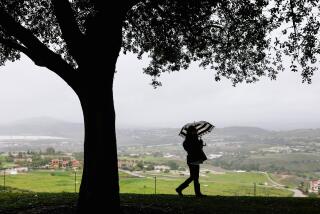On the horns of Devil’s Gate Dam dilemma
On the northernmost edge of Pasadena lies Devil’s Gate Dam, a massive concrete barrier designed to be the last line of defense during massive storms. But now, that dam basin is full of mud with little room for floodwater.
Under a worst-case scenario, torrential rains could send mud, rocks and water over the dam and flooding into the Rose Bowl, South Pasadena and northeast Los Angeles in less than 40 minutes.
Despite stern warnings by Public Works employees that immediate action is necessary to remove the mud, the county Board of Supervisors instead ordered a two-year environmental study before any significant work can begin.
The reservoir “no longer has the capacity to safely contain another major debris event,” the Department of Public Works stated in a report. “There is risk of significant flooding and debris flow below the dam.”
The controversy has centered on the fate of towering willow trees that have sprouted at the bottom of the muddy basin, which provides a home for birds, squirrels and other wildlife. The riparian habitat, a rare site in L.A. County, has also become an oasis for joggers, hikers and equestrians.
Supervisors have also raised concern about 300 to 400 dump trucks moving in and out of the basin each day, and some said they wanted to study whether there’s a better way to remove the mud.
“The evacuation [of mud] is 50 acres with a few hundred willow trees and vegetation. Hikers and horseback riders have used that area behind the dam, and joggers use the trail around it,” Supervisor Michael D. Antonovich said at a recent board meeting.
Citing the potential effect of traffic on nearby schools and residential communities in Altadena and Pasadena, he said, “Community involvement ought to be part of the solution.”
“But would they like mud flows?” Supervisor Don Knabe shot back. “Folks would just be as outraged if something happened and that place overflowed and we got all that stuff down the hill.”
Supervisors Zev Yaroslavsky and Mark Ridley-Thomas joined Antonovich in approving the order in March, while Supervisor Gloria Molina and Knabe abstained.
Public Works officials laid out the warning in dire terms in a subsequent report to the supervisors submitted several weeks ago.
“This sudden sediment … has reduced the reservoir’s volume, and it no longer has the capacity to safely contain another major debris event,” said a report submitted by Gail Farber, who heads the department. “There is risk of significant flooding and debris flow below the dam.”
As a result, many areas near the Arroyo Seco, including homes, horse stables and the 110 Freeway in northeast Los Angeles, South Pasadena and Pasadena are at risk of flooding, the agency said. A dam failure could cause flooding at the Rose Bowl in less than 10 minutes.
Since the Station fire in 2009, about 1.5 million cubic yards of mud have been deposited at Devil’s Gate. Combined with the 100,000 cubic yards of mud that built up between 1994 and 2009, that’s enough to fill four Rose Bowls.
In the meantime, Public Works crews will work on temporary measures, such as removing 25,000 cubic yards of mud closest to the concrete barrier that has buried one of the dam’s drains. They warn, however, that those interim measures could quickly fail.
Devil’s Gate Dam was built in 1920 after devastating floods in the early 20th century, including the flood of 1914, which sent more than a dozen homes and a two-story grocery store building down the arroyo. It was built at a narrow point of the arroyo and got its name from a rock face that looked like the profile of a devil.
The dam area is ringed by a trail. In the mornings, a visitor can hear the calls of many birds that nest in the willows. The yellow warbler, song sparrow and common yellowthroat call the area home. Hummingbirds poke around the trees, squirrels scamper and mallard ducks waddle atop the mud.
“I wouldn’t want to ruin the ecosystem that’s been built up,” said Allison Liddi-Brown as she walked by the dam on a recent morning.
“It’s just a beautiful place. It takes a long time to make another tree,” said Nancy Ries, 62, of La Cañada Flintridge.
But Nancy Rose, 58, of El Monte was torn by the dilemma. She often rides her horse, Sue, near the dam. “I know they need to remove the mud … but think of the environment. We ride here every day. So it’s like, you’re damned if you do, and you’re damned if you don’t,” Rose said. “You see the need, but the outcome can be devastating.”
Public Works’ position has placed it at odds with a host of environmental groups, the Pasadena City Council and some residents. Some Pasadena residents said they strongly organized against the county after the department razed century-old oaks and sycamores in the mountains overlooking Arcadia to make way for a dumping site to scoop mud out of Santa Anita Reservoir.
Tim Brick is managing director of the Arroyo Seco Foundation, which is dedicated to protecting the area. He said the department was trying to ram the project through by taking advantage of the governor’s declaration of an emergency after the Station fire.
“The better approach would be to have an ongoing sediment management program … some every year rather than one big project that was going to amount to 400 trucks a day for three years,” Brick said.
“Everybody else has got to do environmental impact reports,” he said. “Why shouldn’t the county? We don’t want to minimize the flood threat. But the reality is that this dam has been here since 1920. We kind of know what’s likely to occur in this area.”
More to Read
Start your day right
Sign up for Essential California for news, features and recommendations from the L.A. Times and beyond in your inbox six days a week.
You may occasionally receive promotional content from the Los Angeles Times.







